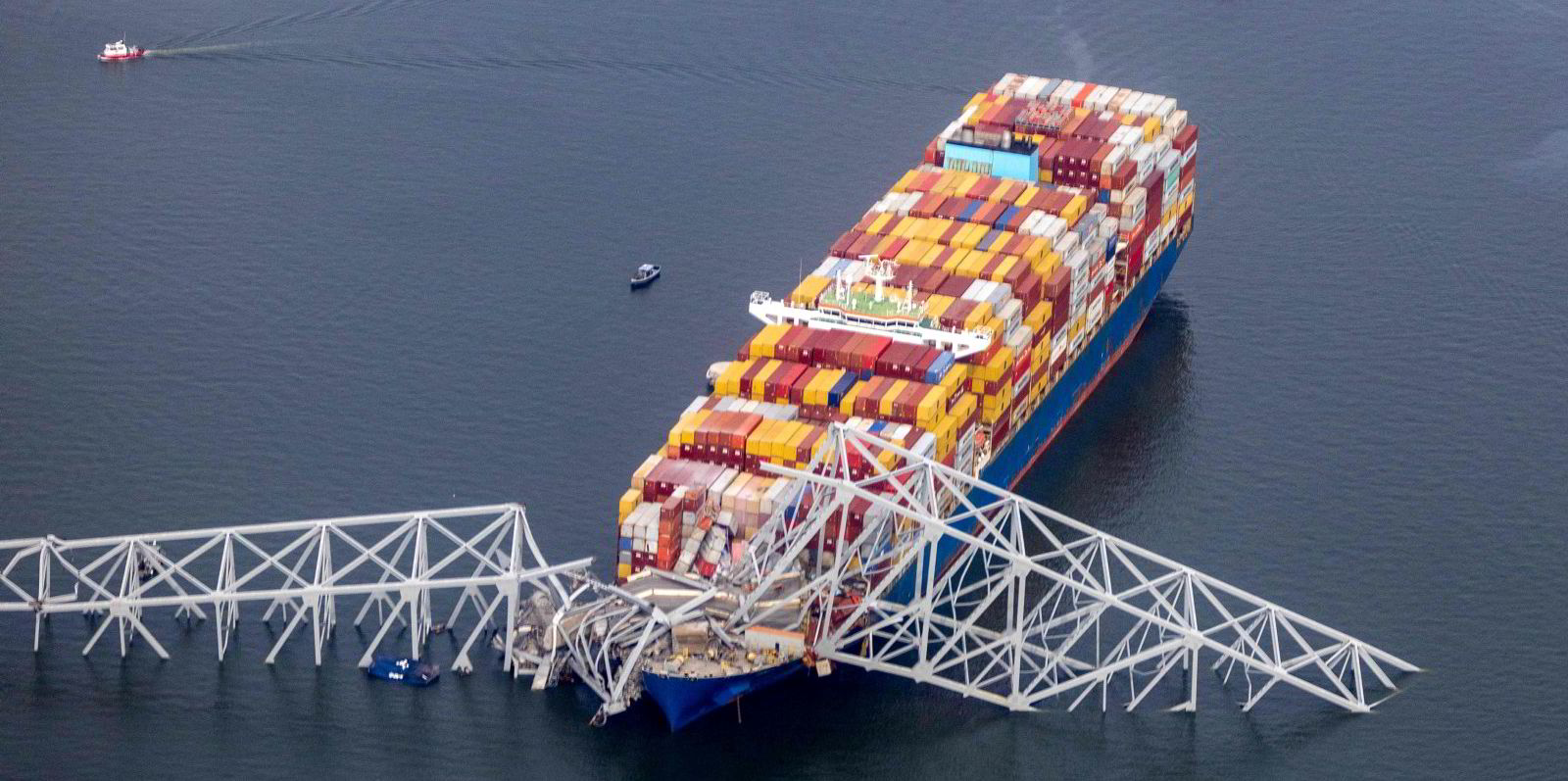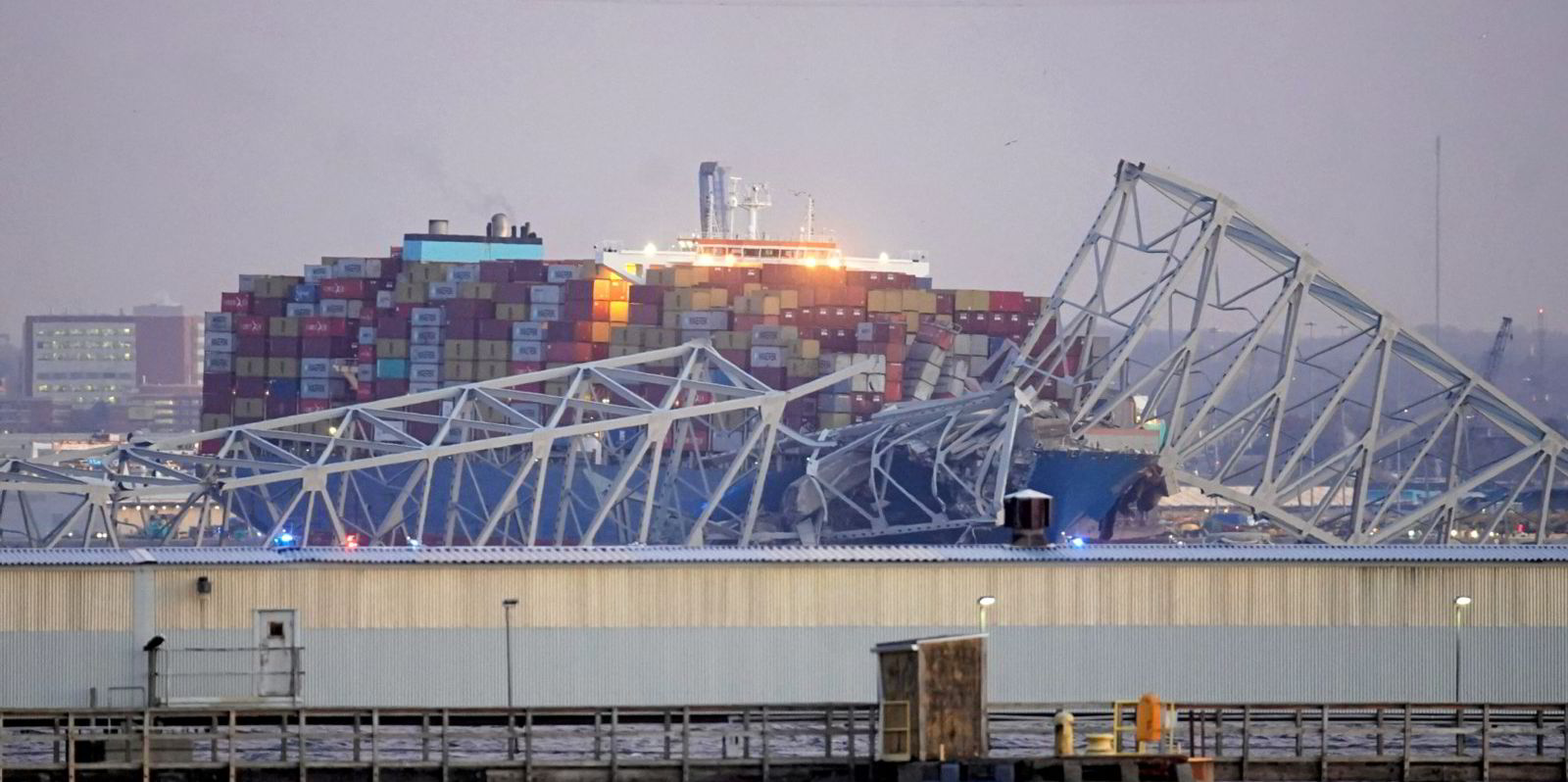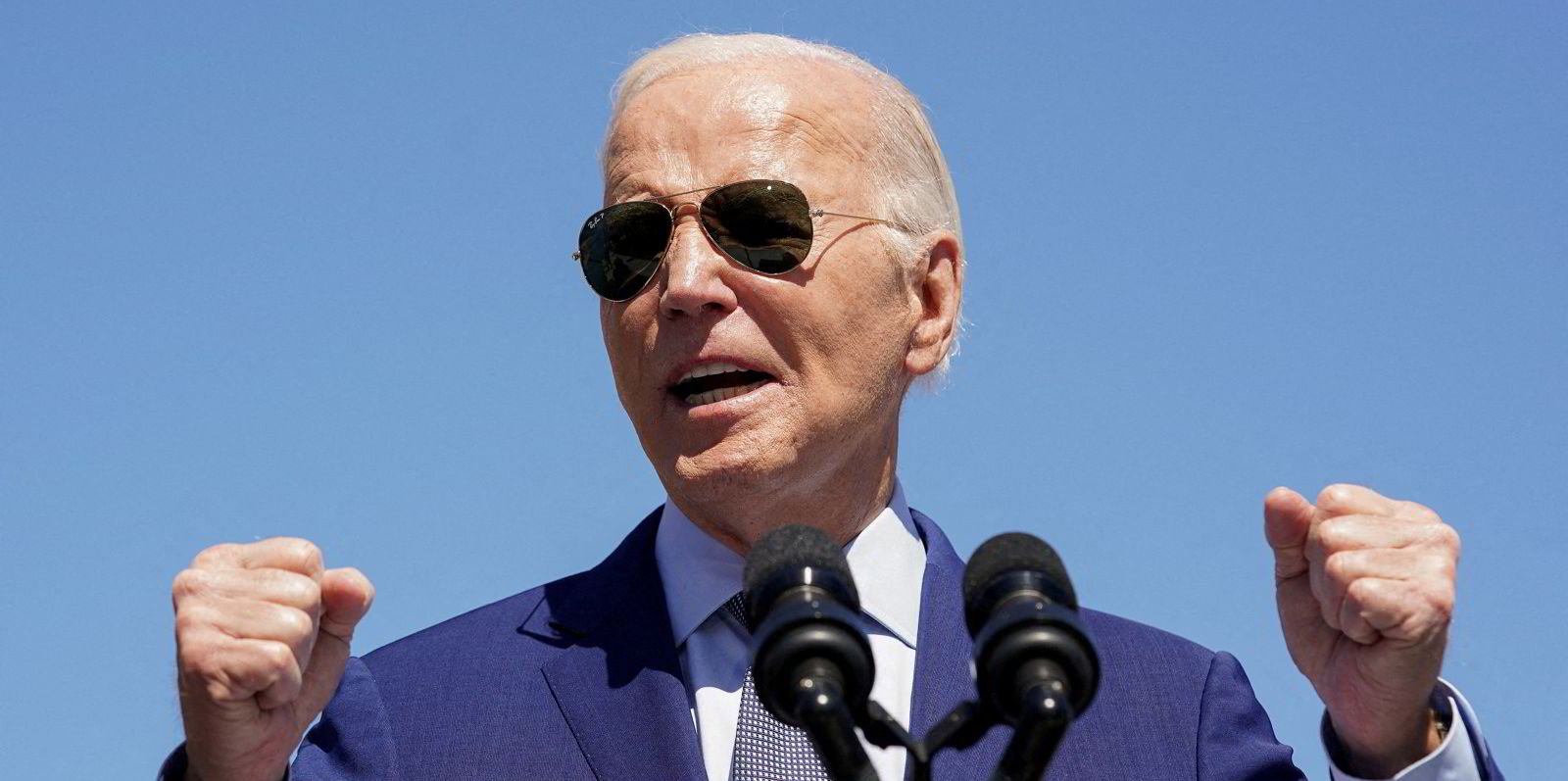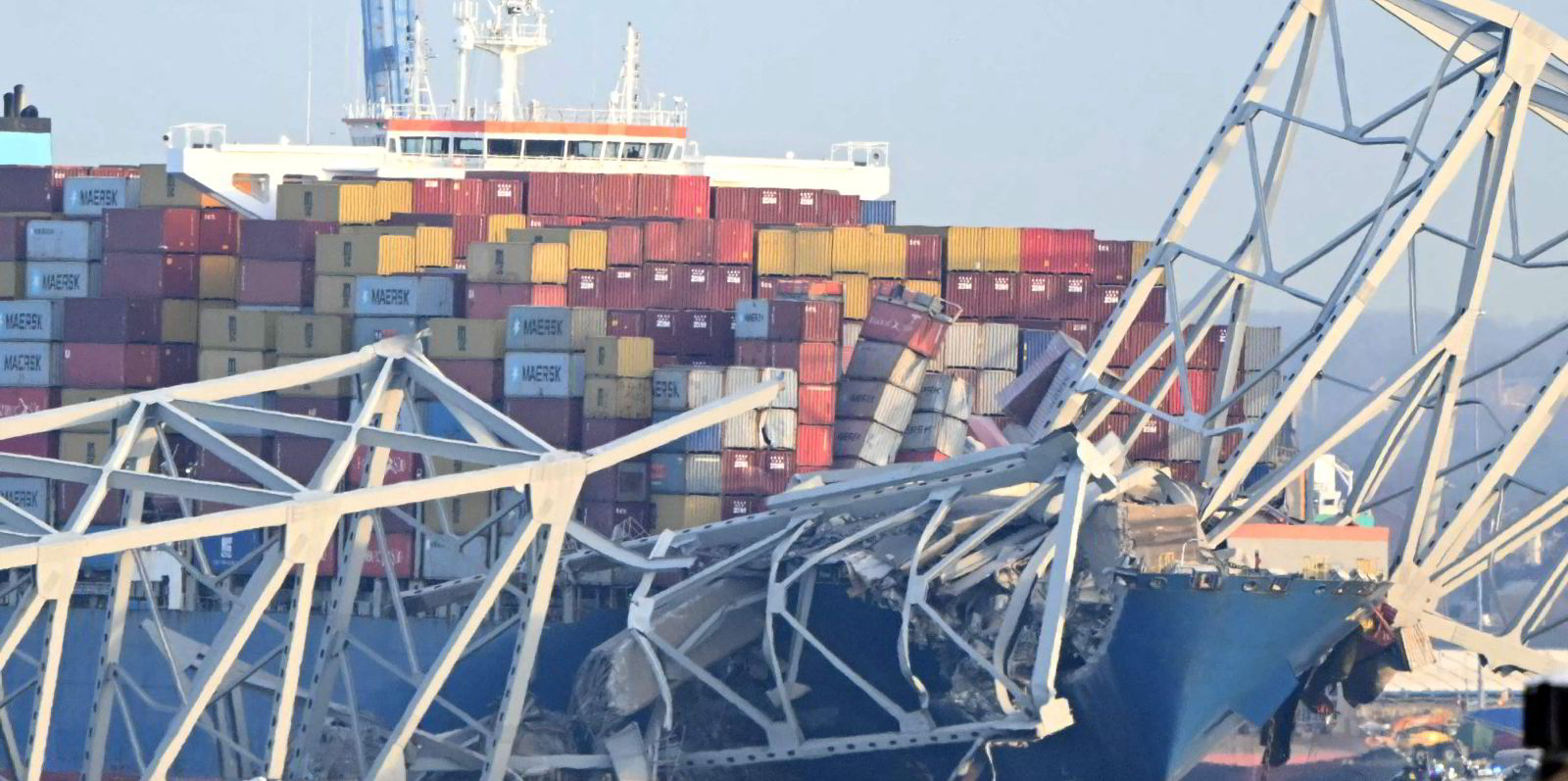Major shipping markets are braced for impact following the collapse of an iconic bridge in Baltimore after it was struck by a Maersk-chartered container ship in the early hours of Tuesday morning.
Pictures and video of sections of the Francis Scott Key Bridge plummeting into the Patapsco River after it was hit by the 9,962-teu Dali (built 2015) made headlines around the world.
The vessel was carrying containers away from one of the major US East Coast ports, but experts believe the disruption will also affect dry bulk and other major markets.
Bulk carriers are apparently trapped inside the port and others are rerouting away in the aftermath of the incident.
The Port of Baltimore said maritime traffic in and out has been suspended. However, it stressed this did not mean the port was closed.
This year to date, Baltimore has been the largest US coal export port in terms of vessel loadings and the 22nd-largest exporter globally. The nearby hub of Hampton Roads — which comprises the ports of Newport News, Virginia and Norfolk — is bigger.
Coal is loaded in Chesapeake Bay at the CNX and CSX terminals at Curtis Bay Piers, owned by transportation group CSX Corp.
The two terminals primarily handle coal from the northern Appalachia region and sometimes US coal from further afield, including central and southern Appalachia, and the Illinois, Colorado River and Powder River basins.
Analysis by Kpler has identified about a dozen bulkers that were expected to load coal at Baltimore’s two terminals before the end of next week.
“These liftings will have to be postponed until the shipping lane has been cleared,” Madeleine Overgaard, Kpler’s dry market data manager, told TradeWinds.
Two vessels are stuck at the coal berths in Baltimore.
Oldendorff Carriers’ 81,262-dwt Klara Oldendorff (built 2019) was stuck at the berth while loading thermal coal at the CNX terminal. An Oceanbulk-operated kamsarmax, the 81,191-dwt JY River (built 2019), is also stuck at the berth.
Overgaard expects gypsum and sugar imports to Baltimore to be disrupted while the port remains closed.
‘Frozen in time’
The coal trade from Baltimore will be “probably frozen in time” for weeks, according to Anton Posner, CEO of Mercury Resources, which manages dry cargo supply chains in North America for producers, consumers, commodity trading companies and banks.
“Every other port is just jam-packed with coal right now — it would take six weeks to send rail cars back up to West Virginia and transfer them to barges. By the time you’ve done that, Baltimore will be open again,” he said.
He expects vessels will be able to access the port again within weeks: “Too much is at stake to shut down a major port like this right now.”
Until the port reopens to ships, Posner expects force-majeure declarations on coal sales contracts and charterparties by traders and shipowners. Vessels, meanwhile, will divert to load coal from other locations.
Baltimore is also a major import hub for steel, zinc, lead and especially aluminium, which is mainly the preserve of handysize bulkers.
The port has commodity warehouses approved by the London Metals Exchange and supplies consumers in the Midwestern US.
With Baltimore out of action, the river port at Owensboro, Kentucky — “the aluminium capital of the Midwest”, as Posner put it — will probably step in as an alternative to feed aluminium to Midwest consumers, he said.
He expects smelters in Quebec, including those operated by Rio Tinto and Alcoa, to divert aluminium cargoes on river barges to be imported from New Orleans, rather than Baltimore.
Barges will make their way upriver from the Gulf Coast, unload at Owensboro and be trucked to end users.
Trade data platform Kpler has identified up to 13 vessels that will likely be affected by Baltimore’s closure to vessel traffic, most of which are due to load coal.
- Phatra Naree — importing alumina from Alumar
- Klara Oldendorff — loading Thermal Coal at CNX Terminal
- JY River — loading coal at Curtis Bay Piers
- Expected vessels — to load coal (currently Baltimore Anchorage).
- Star Triumph — expected to load coal at CNX coal terminal
- One Ocean — expected to load coal CNX
- CSSC Rotterdam — expected to load coal at CNX
- Patroklos — expected to load coal
- Panasiatic — expected to load coal
- Star Majesty — expected to load coal at CNX
- Thalassini Niki — expected to load coal
- CSL Tarantau — expected to load coal at CNX
- Expected vessels — other cargo
- Bonas — expected to deliver wood chips from Basaga International
- Armia Krajowa — expected to deliver her remaining partial cargo of raw sugar at the Baltimore sugar refinery terminal
Months of disruption for containers
Container shipments to the US East Coast face months of disruption following the disaster.
Although no container vessel has been trapped inside Baltimore’s inner port — other than the Dali — access to the terminals is expected to be limited or even impossible for weeks or months, according to Alphaliner.
The immediate impact is to the service in which the Dali was sailing, operated by 2M partners AP Moller-Maersk and MSC Mediterranean Shipping Company.
The Dali operated from Asia and the US East Coast in a service branded TP12 by Maersk and Empire by MSC, with Israeli carrier Zim also taking slots.
The service operates with 11 neo-panamax boxships of between 8,500 teu and 11,000 teu.
Overflow ports
With the collapsed bridge meaning no vessel will be able to enter the container terminals in Baltimore, boxships will be forced to seek to offload containers in nearby ports.
Should the Baltimore cargo be spread solely between the two nearest major container ports, New York/New Jersey and Norfolk in Virginia, this would result in a throughput increase for those ports of just under 10%, according to estimates by container analyst Lars Jensen.
The terminals handled 1.1m teu in 2023, meaning 21,000 teu per week now has to be routed through other ports in the region, he said.
That is expected to have a knock-on impact on other container ships scheduled to enter the port of Baltimore.
However, Freightos head of research Judah Levine said Baltimore’s total quarterly container volumes in the fourth quarter were roughly 13% of those handled by the Port of New York/New Jersey with ocean freight entering its slow season, potentially easing the shifts.
The 8,386-teu MSC Alina (built 2014), operating between the US East Coast and the Mediterranean, was set to call Baltimore but has turned around, Jensen notes.
Other container vessel scheduled to call Baltimore on Thursday are the 8,269-teu MSC Kumsal (built 2006), 4,544-teu Maersk Gironde (built 2002) and 14,424-teu Triton (built 2016).
At least four more boxships were slated to enter the port by the weekend.
The Dali, which is worth nearly $80m, according to VesselsValue, will most likely remain in port while an investigation is conducted.
The vessel had arrived at Baltimore’s Seagirt Terminal on 23 March from Norfolk.
It was scheduled to return to Asia via the Cape of Good Hope and was due to call Colombo in Sri Lanka on 22 April.
The Dali was one of eight wide-beam neo-panamaxes contracted in 2013 by a joint venture between Greek shipowner Oceanbulk Containers and US private equity firm Oaktree Capital.
Oceanbulk sold the Hyundai Heavy Industries-built vessel in 2016 to its current owner Grace Ocean of Singapore.
Car carrier terminal questions
Baltimore is one of the US’ most important ports for automobile and heavy machinery trades. The Maryland Port Administration claims it handles more ro-ro cargoes than any other port in the country.
According to the Maryland Port Administration, most of the Port of Baltimore’s facilities lie inside the beltway linked by the Francis Scott Key Bridge, including the Ports America-run Seagrit Marine Terminal.
Wallenius Wilhelmsen — the world’s largest car carrier operator — has a terminal at the Dundalk Marine Terminal, another large facility inside the beltway.
The company said all its vessels, its terminal and its staff in the area are safe and accounted for.
“First and foremost, our sympathies go to all of those directly affected by the tragic events unfolding in Baltimore,” Wallenius Wilhelmsen said.
“We are working with the relevant local authorities and stakeholders to assess the immediate impact the incident will have upon our ongoing operations.”
At the time of writing, rescuers have recovered two people from chilly waters around the collapsed Francis Scott Key Bridge, but six remain missing.
Follow TradeWinds’ coverage of the disaster here








